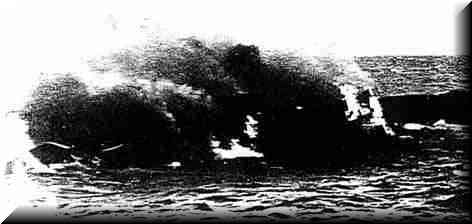[ Page 18 ] To change that situation, by the end of November 1941, "Thor," had been prepared to make her second foray as a Raider, and she left Kiel under Captain Gumprich who had replaced Kahler.
By stages "Thor" crept down the European coastline to arrive at Gironde on the 17th. of December. Under cover of the prevailing bad weather, "Thor" left this port on the 14th. of January 1942.
The continuing bad weather forced this Raider to run for shelter at the Southern end of the Bay of Biscay, then they headed Southward into the Atlantic, until reaching the Antartic Circle.
Using air reconnaissance proved abortive, not an enemy vessel of any kind any where to be found. "Thor" was seeking out the whaling fleets, she now retraced her steps Northwards, and, in the vicinity of Capetown, on the 13th of March, was sighted by the old British Cruiser 'Durban." The challenge brought a response from the Raider, that she was the British freighter 'Levernbank," thus satisfied, "Durban" proceeded on her way.
On the following day, the A.M.C. "Cheshire" also challenged "Thor" who blandly replied that she was a British ship - again the bluff worked, and the Raider again got away with it!
Eventually, these two episodes when reported, brought forth an enquiry from the British Admiralty which showed that neither Warship had any way of really finding out that "Thor" was not the vessel she claimed to be. These obvious blunders sparked attempts at tightening up the challenge and reply system to ensure phoneys were unmasked.
"Thor," on her way to meet a replenishment ship, the 'Regensburg' sighted funnel smoke on the horizon. It was the 23rd. of March, the smoke emanated from the 3,942 ton Greek "Pagasitikos," a torpedo sent her to the bottom, and 32 men and one woman were taken aboard the Raider.
In many cases during the war it was flinnel smoke that gave away the whereabouts of a merchant ship to an enemy Raider or hostile Warship, a ship producing smoke was frowned on by the Commodore of a convoy. it put the whole convoy at risk by drawing attention to them, and if a ship was on its own, smoke would bring down the Captain's wrath upon the engine room watchkeepers.
The same rules applied to Warships, smoke free conditions, allowed suprise to be maintained. For old coal burning ships, it was a most difficult task to proceed at any speed without producing a telltale swirl of smoke from their flinnels, but try, to remain smokeless, was the constant aim of all ships' engine room personnel.
The following day replenishment was achieved, and the ocean was combed for targets, on the 28th. of March masts were sighted,but after a 3 hour chase it needed to be abandoned as "Thor" was too slow to catch her potential victim.
In another 2 days her seaplane found the British ship "Wellpark," which "Thor" had to pursue for 7 hours before stopping her with gunfire. The sea plane had also attacked this ship but was driven off by accurate AA defence. The ship was abandoned and scuttled, "Thor" continued her search.
British ship "Wellpark"



This site was created as a resource for educational use and the promotion of historical awareness of the Gustloff and associated events. All rights of publicity of the individuals named herein are expressly reserved, and, should be respected consistent with the reverence in which this memorial site was established.
Copyright © 1984/1999 Computrain All rights reserved

